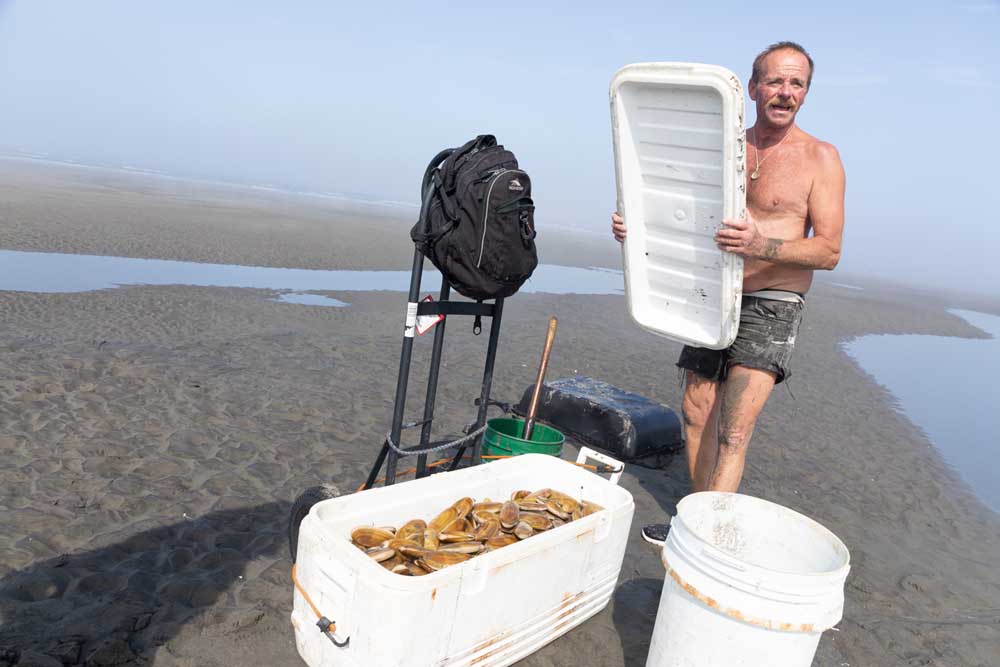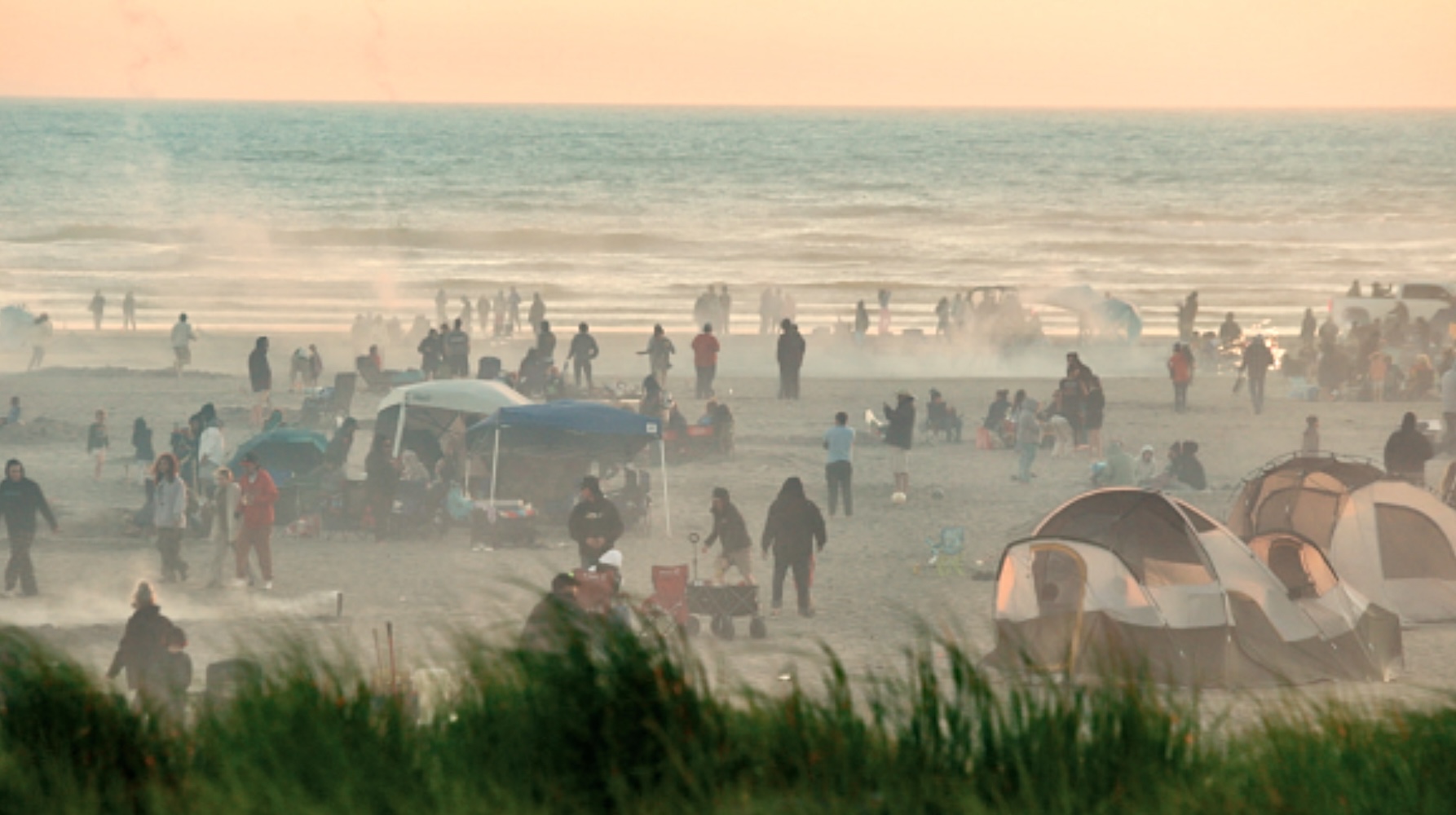Big risk, big clams: Hardy commercial diggers sustain long tradition
Published 2:19 pm Monday, August 9, 2021

- “At $3.75 per pound, I’ve never made more money this quickly,” said Les Strange, 58, of Raymond, standing over a 50-quart cooler of clams. After averaging $2.20 in 2020, commercial diggers like Strange are hopeful the current market demand will continue.
WILLAPA SPITS — On isolated, shifting spits in seemingly perpetual fog, some dig their living from the sand.
Razor clammers each collected about 110 pounds per day on average last season, but diggers are finding more clams and a more favorable market this year, making for some memorable days for the relatively small group who work the detached Willapa Spits off the north end of the Long Beach Peninsula.
“At $3.75 per pound, I’ve never made more money this quickly,” said Les Strange, 58, of Raymond, standing over a 50-quart cooler of clams. After averaging $2.20 in 2020, commercial diggers like Strange are hopeful the current market demand will continue.
“That’s pretty much what I do for a living all year. It’s back-breaking work, but you get in shape. You get out what you put into it. You can’t beat that,” said Strange, adding that he hoped to dig 250 pounds that day.
High risk, reward
In Pacific County, the commercial harvest is allowed only on the Willapa Spits, located within the mouth of Willapa Bay. The sand spits, only accessible by boat, present unique challenges and opportunities for commercial diggers each season. The relatively small area has abundant clam numbers and accounts for an outsized portion of the state’s commercial clamming.
“For the past 10 years, they’ve accounted for about 35% of the [commercial] harvest. Just this little area in the spits is a pretty big producer,” said Washington Department of Fish and Wildlife coastal shellfish biologist Zach Forster during a recent patrol of the grounds in late July.
The reward, however, doesn’t come without risk. In order to reach the area, diggers must arrive by boat, since it’s illegal to drive on the beaches leading to where the sand spits begin. Clammers come on small skiffs, often relying on GPS plotters to navigate through the heavy fog that frequently blankets the area.
“It only occurs on the detached spits of Willapa Bay. The only way diggers can access the spits are by boat. It’s boat-in only, which limits any potential interaction with driving on the beach or [bird] nesting,” Forster said.
The shifting sand spits are several hundred yards from the peninsula, and sometimes disappear underwater depending on the tides.
“They’re probably under 6 to 10 feet at high tide. It’s breaking surf on the spits typically. It’s all sub-tidal. They change from year to year. One area of the spits that’s good digging might not even show the next year,” Forster said.
Diggers dwindle
Participation among licensed commercial clammers in Washington has declined over the past five years, from 132 diggers in 2015, to 68 in 2020 to just 29 this year. Scores of commercial diggers once ranged the sands of Pacific and Grays Harbor counties.
An aging workforce and seasonal disruptions due to domoic closures are considered the primary reasons for the drop in participation.
The season typically starts in April and lasts about eight weeks, but was delayed until July this year due to a common neurotoxin.
“We had a late start this year because of issues with domoic acid. The same that affected the recreational beaches also affected the clams on the Willapa Spits. We continued to test from March clear through July, when we got our two good [back to back] samples to open,” Forster said. “July 2nd we got the green light from the Department of Health and we announced the opening date from July 10 running through Aug. 31, with the possibility of extending the fishery into September.”
Despite the seasonal disruptions, dedicated diggers return year after year, like David Tegen, 68, of Westport. On his best day, Tegen once dug 389 pounds. But on a Wednesday morning in late July, he had more moderate goals.
“I like to get up around 200 (pounds) or better,” he said. “But my age is catching up with me.”
Evolving razor clam market
In 2020, Pacific County accounted for 71% of the statewide commercial clam harvest, followed by Grays Harbor with 25%. The fishery landed 184,379 pounds of clams last year during an 87-day season, representing an ex-vessel value of about $415,000, the fifth highest on record.
A majority of the commercial clam harvest historically went to the commercial bait market, where they’re a popular choice for everything from Dungeness crab to surf perch.
“A reason a good majority have been sold to the crab market is because, if you talk to a commercial crabber, they’ll tell you razor clams are the best bait. They’re going to get sold where the demand is,” Forster said.
Lately however, a growing percentage is destined for the fresh seafood market, as much as 40%. Many local seafood retailers and restaurants now have razor clams readily in stock or featured on menus. Commercial-harvested Pacific razor clams are considered a “best choice” among sustainable seafood, according to Seafood Watch.
“Their population is mostly driven by natural mortality and recruitment, not the recreational or commercial harvest,” Forster said.
And by the way, preliminary population surveys on the peninsula’s ocean beach indicate strong numbers for this coming fall’s digs — if domoic levels stay below 20 parts per million.
See wdfw.wa.gov/fishing/commercial/razor-clam to learn how to become a commercial digger.









